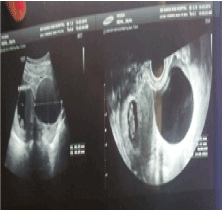
Ovarian Cysts in Early Pregnancy: A Comprehensive Guide
Ovarian cysts are fluid-filled sacs that develop on the ovaries. They are common during pregnancy, affecting approximately 5-10% of women. While most ovarian cysts are benign (non-cancerous), some can cause discomfort or complications.
Types of Ovarian Cysts in Early Pregnancy
There are several types of ovarian cysts that can occur during early pregnancy:
- Corpus luteum cyst: This is a normal cyst that forms after ovulation. It usually resolves on its own within a few weeks.
- Follicular cyst: This type of cyst develops from an immature egg follicle. It typically disappears within a few months.
- Theca lutein cyst: These cysts are associated with high levels of the hormone hCG, which is produced during pregnancy. They usually resolve after delivery.
- Dermoid cyst: These cysts contain various tissues, such as hair, teeth, or skin. They are rare and may require surgical removal.
- Endometrioma: These cysts are filled with endometrial tissue, which is the lining of the uterus. They are associated with endometriosis, a condition where endometrial tissue grows outside the uterus.
Symptoms of Ovarian Cysts in Early Pregnancy
Most ovarian cysts do not cause any symptoms. However, some women may experience:
- Pelvic pain or pressure
- Bloating or abdominal distension
- Nausea or vomiting
- Irregular vaginal bleeding
- Painful intercourse
- Difficulty urinating or having bowel movements
Diagnosis of Ovarian Cysts in Early Pregnancy
Ovarian cysts are typically diagnosed through a pelvic exam and ultrasound. During the pelvic exam, the doctor will feel the ovaries for any lumps or masses. Ultrasound is a non-invasive imaging test that uses sound waves to create images of the ovaries and uterus.
Treatment of Ovarian Cysts in Early Pregnancy
Most ovarian cysts do not require treatment. However, if a cyst is causing symptoms or is suspected to be cancerous, treatment may be necessary. Treatment options include:
- Observation: If the cyst is small and not causing any symptoms, the doctor may recommend monitoring it with regular ultrasound exams.
- Medication: In some cases, hormonal medications may be used to shrink the cyst or prevent it from growing.
- Surgery: If the cyst is large, causing severe symptoms, or suspected to be cancerous, surgery may be necessary to remove it.
Risks of Ovarian Cysts in Early Pregnancy
Ovarian cysts can increase the risk of certain complications during pregnancy, including:
- Ovarian torsion: This is a condition where the ovary twists on its supporting ligaments, cutting off its blood supply. It can cause severe pain and may require emergency surgery.
- Premature birth: Ovarian cysts may increase the risk of premature birth, especially if they are large or cause significant symptoms.
- Cesarean delivery: Ovarian cysts may make it difficult for the baby to descend through the birth canal, increasing the likelihood of a cesarean delivery.
Prevention of Ovarian Cysts in Early Pregnancy
There is no known way to prevent ovarian cysts. However, maintaining a healthy weight and getting regular exercise may reduce the risk of developing cysts.
Conclusion
Ovarian cysts are common during early pregnancy. Most cysts are benign and do not cause any symptoms. However, some cysts can cause discomfort or complications. If you experience any symptoms of an ovarian cyst, it is important to see your doctor for evaluation and treatment. With proper diagnosis and management, most ovarian cysts can be resolved without any long-term effects on the pregnancy.